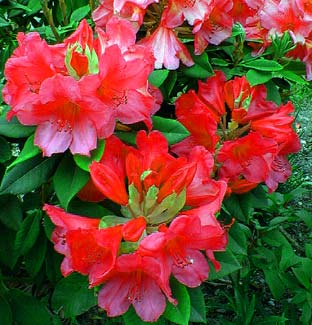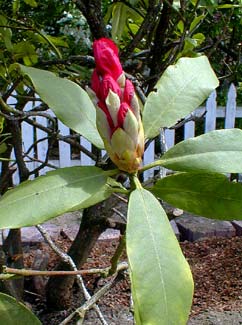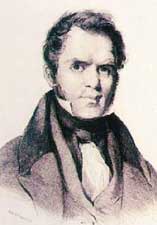 Rhododendron x griffithianum
Rhododendron x griffithianum
'The Honorable Jean Marie de Montague'
"I see her in the dewy flowers,
I see her sweet & fair;
I hear her in the tunefu' birds,
I hear her charm the air:
There's not a bonnie flower that springs
By fountain, shaw, or green,
There's not a bonnie bird that sings,
But minds me o' my Jean."
-Robert Burns
(1759-1796)
(1759-1796)
This cultivar's long name, 'The Honorable Jean Marie de Montague,' is generally shortened to 'Jean Marie de Montague' or simply 'Jean Marie' for sake of practicality or affection. But it is charming to find it not only listed in such important overviews as Greer's Guide to Available Rhododendrons by its fuller name, but actually alphabetized under the word "The."
Developed in Holland by C. B. van Nes & Sons about 1901 (though not in general production until the 1930s) 'Jean Marie' was for decades regarded as the best of all red rhododendrons. When the buds have matured, there is no more perfect red in existance. The flowers open to a slightly paler red, with faint freckles on the inner uppmost petal.
 Many regard the other excellent red Ironclad, 'Nova Zembla,' as having too much blue in its spectrum to be the truest red. Several other intensely red rhododendrons have been hybridzed in the last two decades, yet it remains that the measure of a good red is how well it compares to 'Jean Marie.'
Many regard the other excellent red Ironclad, 'Nova Zembla,' as having too much blue in its spectrum to be the truest red. Several other intensely red rhododendrons have been hybridzed in the last two decades, yet it remains that the measure of a good red is how well it compares to 'Jean Marie.'A cross between R. griffithianum & an unknown pollinator, the species it is derived from is native to the Himalayas, where it has been seen growing in the wild to the astounding height of fifty feet.
R. griffithianum is the shrub that Kew Gardens' famous plant explorer Sir Joseph Dalton Hooker (1817-1911) brought back from his expedition to Sikkim in the Himalayas, & named R. aucklandii after his friend the Earl of Auckland, former Governor-General of India.
 It was renamed in 1850 by the Scottish surgeon & expert on Himalayan flora, Dr. Robert Wight (1796-1872), shown in the portrait here at the left. He recognized what Sir Joseph had not, that his late friend & fellow physician William Griffith (1810-1845), head of the Calcutta Botanic Garden, had already collected specimens in 1835, in Bhutan.
It was renamed in 1850 by the Scottish surgeon & expert on Himalayan flora, Dr. Robert Wight (1796-1872), shown in the portrait here at the left. He recognized what Sir Joseph had not, that his late friend & fellow physician William Griffith (1810-1845), head of the Calcutta Botanic Garden, had already collected specimens in 1835, in Bhutan.It was a specimen brought to England by Hooker that bloomed in 1858, & at once so captivated horticulturalists of the time, it was immediately being used for hybrid purposes, typically crossed with North America's R. cawtabiense so that the Catawba rhododendron & Griffith's rhododendron became the primary backbones of the classic Ironclads.
R. griffithianum is naturally white-flowering often with red blush, rarely with crimson bracts, so 'Jean Marie' gets its deep full red from its unknown pollinator.
'Jean Marie' has very large evergreen leaves. It is hardy to around minus five degrees (vs R. griffithianum which is hardy to about ten degrees F.), & is also one of the most sun-hardy of all elipedote rhododendrons.
We obtained ours as a mature shrub from a friend as a gift in exchange for digging & moving it out of his garden. For decades it had been growing at the head of a walkway in full morning & afternoon sun, seemingly no worse for wear. So we were confident it would do well on our roadside, with enough shade from the morning side that even in this exposed spot it would be getting less sun than it had previously.
It was a bear to dig up. The root went down for three feet (twice as deep as I'd expected, since rhody roots are extremely shallow) & the roots also spread outward well beyond the dripline. We had to trim the roots at the dripline, & took over an hour of sweat to trench deep enough to pry it out of the hole. By comparison, when we moved an old 'Catawba Album' from the same yard into ours, the root was so shallow that when I spaded around the dripline to only the depth of the spade, the whole shrub popped out of the ground like a pancake off a griddle.
In replanting 'Jean Marie,' I had to dig it an unusually large hole, & mixed into the soil a heck of a lot of organic matter to hold moisture for its recovery from getting the roots so beaten up. We had no choice of time to move it, & it was in full bud, & we had so much trouble managing its weight that a goodly portion of the buds were knocked loose. I'd half expected the rest of the buds to just dry out from the shock, but it continued blooming as if nothing had happened, & the May photos on this page are from its first season at our house
The trunk showed signs of heavy pruning in years past (it was right beside a sidewalk so couldn't be allowed to get too wide). It nevertheless has very handsome form with attractive bark on the old limbs. It stands six feet tall & wide.
For more photographs of this shrub, go to the:
'Jean Marie de Montague' Page of the Rhododendron Gallery